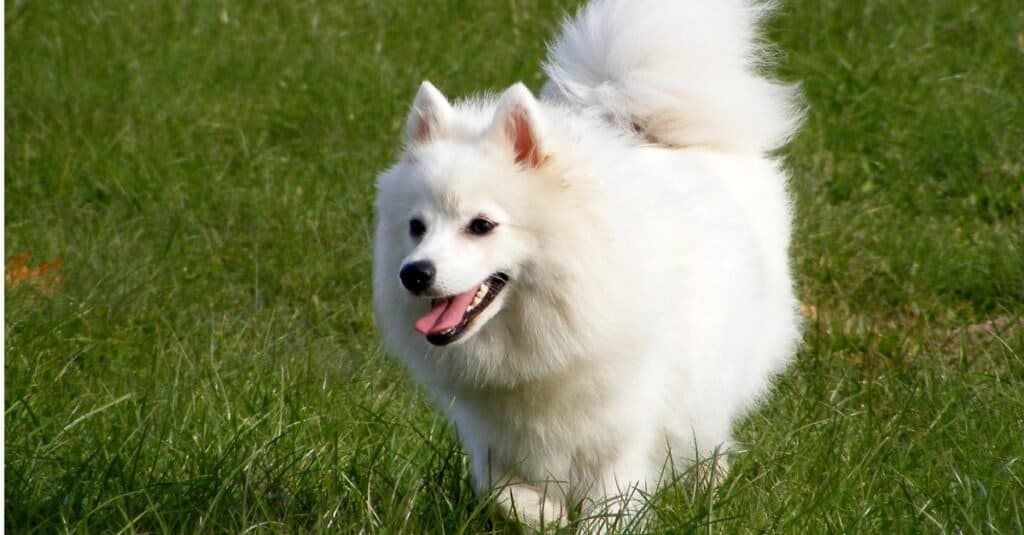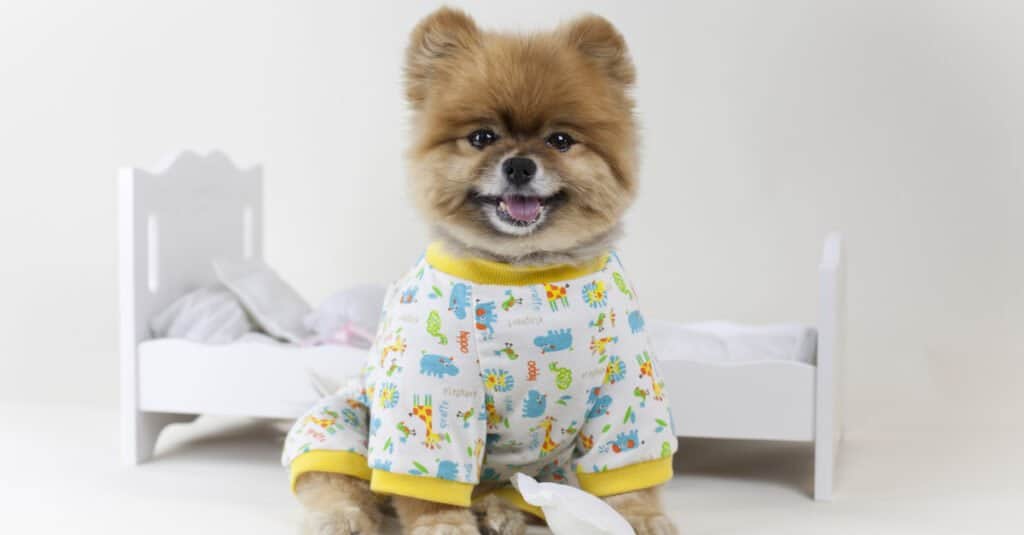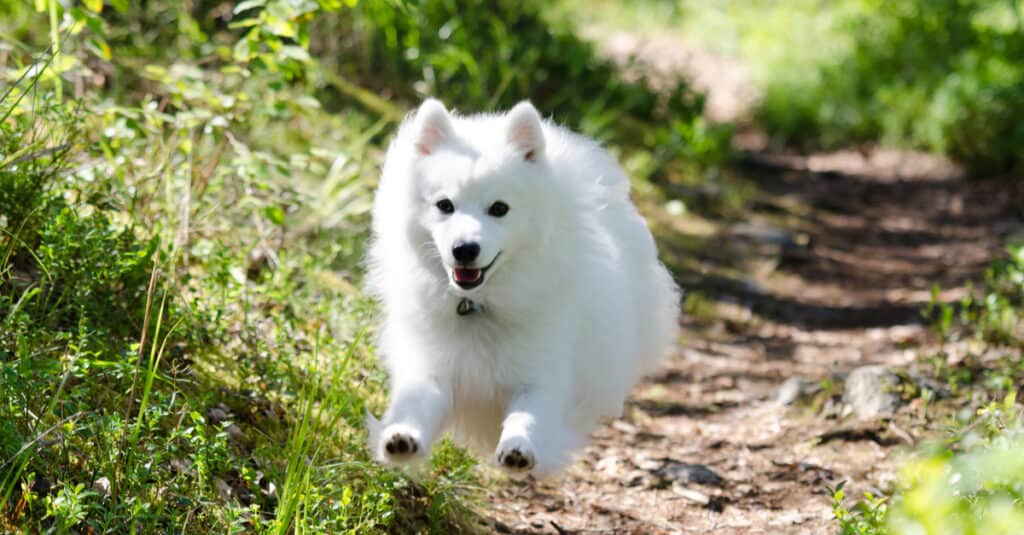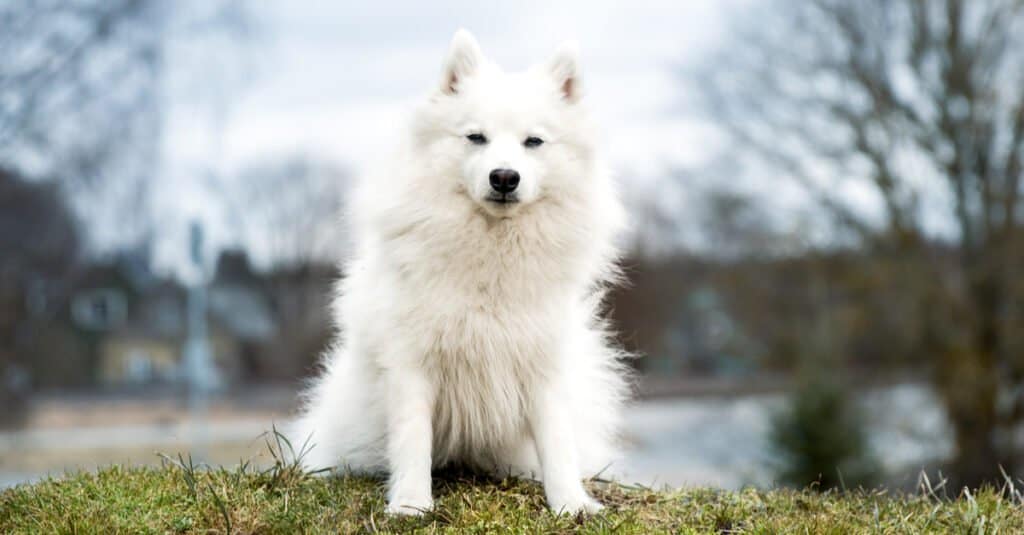The Japanese spitz and the pomeranian are both spitz dogs, a group comprising northern breeds with fluffy coats, pricked ears, tails curved over the back, and a wolflike or foxlike appearance. Though spitzes vary greatly in size and include the large Alaskan malamute and chow chow, they also embrace smaller breeds like the two we’ll look at today. Read on to discover the similarities and differences between the Japanese spitz vs. the pomeranian.

The Japanese spitz and pomeranian share the same foxlike face.
©joonasp/Shutterstock.com
Comparing a Japanese Spitz vs. a Pomeranian
Below you will find a table comparing the five main traits of these two breeds:
| Japanese Spitz | Pomeranian | |
|---|---|---|
| Breed Origin | Japan | Poland and Germany |
| Appearance | White hair; long-haired; mane around neck; foxy face; erect ears; curled, feathery tail; deep chest; square body | Long-haired; mane around neck; foxy face; erect ears; curled, feathery tail; deep chest; square body |
| Size | Male: 12-15 inches, 10-25 pounds Female: 12-15 inches, 10-25 pounds | Male: 7-12 inches, 3-7 pounds Female: 7-12 inches, 3-7 pounds *Teacup pomeranians weigh less than 3 pounds |
| Hair Type and Colour | Hair colour: white Hair type: long-haired; double coat; sheds heavily and seasonally | Hair colour: white, red, orange, blue, beaver, black, cream, chocolate, merle, brindle, black and tan, wolf sable, tri-coloured Hair type: long-haired; double coat; sheds heavily and seasonally |
| Temperament | Affectionate, loyal, playful, alert, active, intelligent, courageous | Affectionate, alert, playful, active, intelligent, courageous; confrontational toward other dogs |
The 5 Main Differences Between a Japanese Spitz and a Pomeranian
Though these two breeds may appear similar, there are notable differences between them. Read on to find out how they compare in terms of breed origin, appearance, size, hair type, colour, and temperament.
Breed Origin

Though pomeranians originated in Poland and Germany, Queen Victoria of England made them popular worldwide.
©Eve Photography/Shutterstock.com
The Japanese spitz originated in Japan in the 1920s and 1930s. Breeders combined other spitz breeds like the white-haired German spitz to create the unique breed we know today. Some of these breeds came from northeastern China, Canada, America, and Australia. The Japanese spitz first debuted at a dog show in Tokyo in 1921. Unfortunately, World War II resulted in the destruction of records providing further details of this breed’s history.
The pomeranian got its name from the Pomerania region of northwest Poland and northeast Germany. Here, breeders created it from much larger and stronger spitz sled dogs. Due to its origins in the Arctic, the pomeranian still carries a thick double coat. Though the pomeranian had already been around for hundreds of years, Queen Victoria made the breed popular by taking several individuals home with her to England. She ordered breeders in her homeland to create a smaller version of the breed, resulting in the toy dog we see today.
Appearance

The Japanese Spitz often goes by the name “cloud dog” for its
fluffy white coat
.
©iStock.com/virgonira
The Japanese spitz is a fluffy dog with an overabundance of hair. Its long, luxuriant white coat grows especially thick around the neck. A foxlike face and erect ears give it a pert, alert expression suited to its personality. As an athletic breed, the Japanese spitz has a muscular, stocky body with a deep chest. A curled, feathery tail arches over its back.
Pomeranians closely resemble Japanese spitzes with their athletic, square bodies and abundance of hair. Their tails are likewise curled and feathery and their neck ruffs are dense. Their faces carry the same foxy, alert expression with pricked ears. However, unlike the Japanese spitz, their hair colour varies widely.
Size

Pomeranians are toy dogs, weighing no more than three to seven pounds. Some are even smaller than this.
©Sarah Lew/Shutterstock.com
The Japanese spitz is a small to medium dog depending on the size of the individual. Despite being relatively small, this breed is always larger than the pomeranian. Males and females don’t differ much in size with a height of 12-15 inches and a weight of 10-25 pounds.
Pomeranians, on the other hand, don’t reach either this size or this weight. Rather, they find their niche in the toy dog category. Males and females alike only reach 7-12 inches in height with an average weight of 3-7 pounds. Some dogs within this breed are even tinier, falling in the “teacup” category. However, the American Kennel Club (AKC) does not recognise pomeranians under 3 pounds, classifying them instead as a teacup spitz.
Hair Type and Colour

Unlike the Japanese Spitz, Pomeranians come in a wide variety of colours and patterns.
©Eva Sustar/Shutterstock.com
The Japanese spitz’s fluffy white hair has earned it the nickname “cloud dog.” Its abundant white mane is iconic, especially the ruff around its neck. It has a double coat with a thick, dense undercoat that it sheds twice a year and a long, soft outer coat. Unfortunately, this breed sheds heavily and is definitely not hypoallergenic.
Unlike the Japanese spitz, pomeranians come in a wide range of colours. Though some may look like miniature Japanese spitzes with pure white coats, many also sport other solid colours like red, orange, blue, beaver (light brown), cream, chocolate, and black. They also come in a variety of patterns like black and tan, merle (red and white against a tan base), brindle (red, gold, orange, and black streaks), wolf sable (grey fur with black nose, eyelids, lips, and paw pads), and tri-coloured (black, tan, and white).
Like their Japanese cousins, pomeranians have double coats with a dense undercoat (shed or “blown” seasonally in spring and fall) and a longer outer coat. They shed moderately throughout the year and heavily during spring and fall. For this reason, they are not hypoallergenic.
Temperament

Japanese spitzes are active, playful dogs much like their pomeranian counterparts.
©joonasp/Shutterstock.com
The Japanese spitz has a good reputation as a family pet. This breed is affectionate, good-natured, and loyal. Alert and courageous, they make great watchdogs in addition to being natural companions. They typically get along fine with other dogs in the household and make gentle playmates for young children. In addition to this, they are intelligent and easy to train.
Pomeranians share the Japanese spitz’s playful, sociable demeanour. They make lovable family pets with plenty of affection to go around. Training is typically easy with this breed as they are highly intelligent and eager to please. They also make great watchdogs with an alert and ready temperament. However, they tend to be more confrontational toward other dogs than the Japanese spitz, often barking or lunging at dogs much larger than themselves.
Lifespan

The Japanese spitz makes for an affectionate family pet.
©Lisjatina/Shutterstock.com
The Japanese spitz has a fairly long lifespan of 10-16 years. However, owners should watch out for some common health issues. One of them is patellar luxation, a condition that causes the dislocation of the kneecap. Dogs with patellar luxation may suffer from lameness or other effects. The Japanese spitz also frequently suffers from runny eyes, a condition that often stems from undersized tear ducts or allergies. Other possible issues include cancer and arthritis, both of which become likelier as the dog ages.
The pomeranian is also long-lived with a lifespan of 12-16 years. Like the Japanese spitz, they also may suffer from patellar luxation. Another common health issue is tracheal collapse, a condition that causes the windpipe to collapse during inhalation. This is due to the weakening of the trachea’s supportive cartilage rings. Less commonly, pomeranians may lose their coats due to a condition called Alopecia X.
Grooming Needs

The pomeranian requires more grooming maintenance than the Japanese spitz.
©Parilov/Shutterstock.com
Despite their abundant hair, the Japanese spitz is a fairly low-maintenance dog. Weekly brushing is essential to keep them looking their best and to prevent tangles and knots. It’s vital to check behind the ears regularly as this is a hotspot for tangles. During moulting (seasonal heavy shedding), groomers recommend daily brushing to keep the shedding under control. A bath every couple of months should be sufficient.
Pomeranians may be smaller than the Japanese spitz, but they actually require more grooming. Groomers recommend brushing pomeranians at least 2-3 times per week or daily during peak shedding periods. They should be bathed at least once every 3 weeks, though once a week is ideal.
Though the Japanese spitz and pomeranian require diligent grooming and are not hypoallergenic, their alert, affectionate, intelligent temperaments make them excellent family pets.
Up Next:
- 10 Types of Japanese Dog Breeds
- Japanese Spitz s. Samoyed: The Key Differences
- 9 Adorable Teacup Dog Breeds
- 10 Incredible Pomeranian Facts
The photo featured at the top of this post is ©
Ready to discover the top 10 cutest dog breeds in the entire world?
How about the fastest dogs, the largest dogs and those that are -- quite frankly -- just the kindest dogs on the planet? Each day, AZ Animals sends out lists just like this to our thousands of email subscribers. And the best part? It's FREE. Join today by entering your email below.
Thank you for reading! Have some feedback for us? Contact the AZ Animals editorial team.







